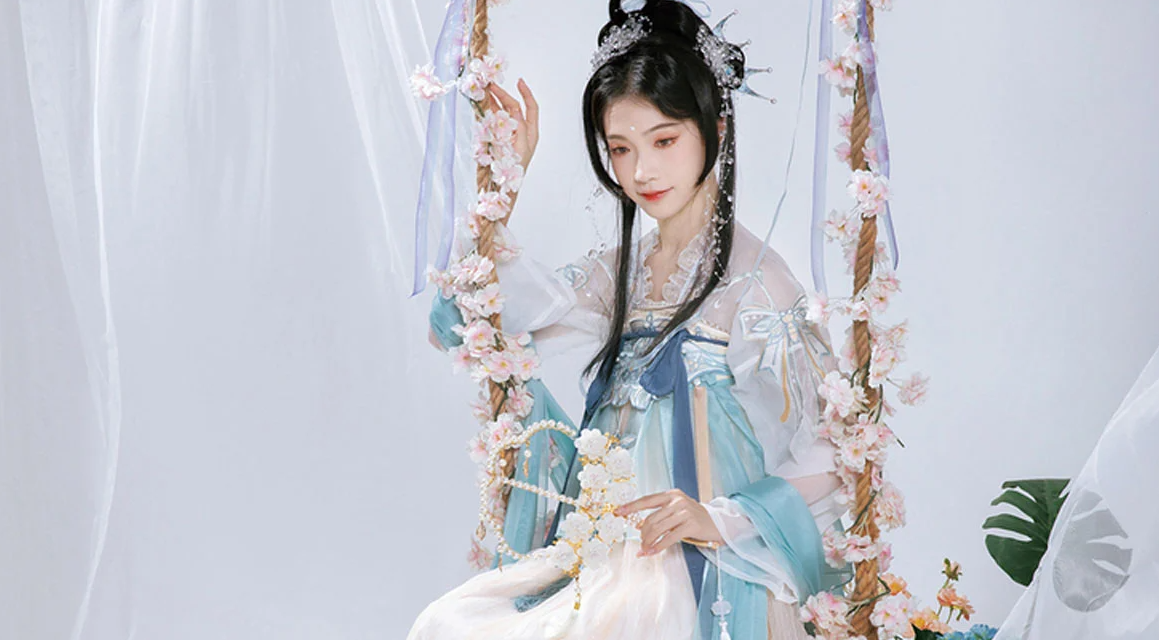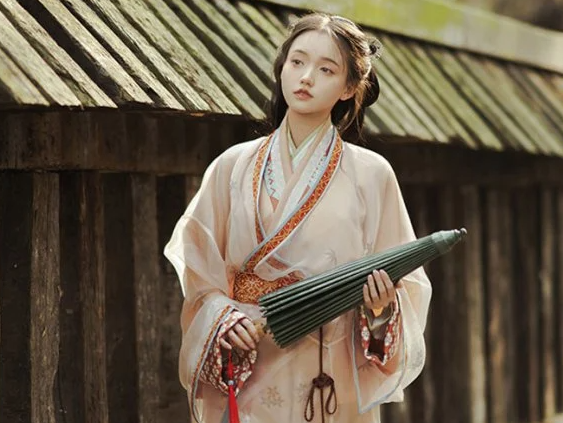Hanfu’s legendary origin ties to the Yellow Emperor and his wife Leizu, who pioneered silk weaving.
The Legendary Origins of Hanfu
The Yellow Emperor and His Wife’s Influence
One of the legends associated with him is his wife, Leizu, discovering silk production. Leizu observed silkworms spinning cocoons and subsequently developed the idea of weaving the silk threads into cloth. This gave birth to the silk industry in China, which would go on to influence the development of Hanfu. The Yellow Emperor, seeing the value and beauty of the silk, encouraged its use in creating clothing that symbolized China’s refinement and cultural identity. This early support for silk and its incorporation into clothing set the foundation for what we know as Hanfu today. More about Yellow Emperor on Wikipedia.

The Mythological Significance of the Silk Worm
In ancient China, the silkworm was revered not only for its economic value but also its cultural and mythological significance. The Chinese believed that the silkworm was a gift from the heavens, and its ability to produce silk was almost magical. This reverence for the silkworm and its silk was deeply intertwined with the development of Hanfu. The silk produced was of the highest quality, with a luster and softness that was unmatched by any other material. Each strand of silk measured about 1,000 meters in length, and the quality of silk was determined by its sheen, softness, and elasticity. Hanfu made from this silk showcased China’s technological prowess and its deep connection with nature. Read more about Silkworm Mythology on Wikipedia.
Popular Folklore Surrounding Hanfu’s Inception
Several tales in Chinese folklore highlight the origins and evolution of Hanfu. One such story speaks of a goddess who descended to Earth and was enamored by the elegance and beauty of the people’s clothing. She took inspiration from nature – from the flowing rivers, the graceful willow branches, and the ethereal clouds. Incorporating these elements, she created the first Hanfu. The goddess’s creation was so beautiful that it caught the attention of the Jade Emperor in heaven, who then decreed that Hanfu would be the official attire for all celestial beings. Another tale speaks of a commoner who, in a dream, was shown a vision of the perfect attire that balanced both form and function. Upon waking, he meticulously crafted what he had seen, giving birth to the earliest design of Hanfu. This dream-inspired creation was so impressive that it was adopted by royalty and became a staple for ceremonial events. Discover more Hanfu Tales on Wikipedia.
Hanfu Through the Dynasties
Hanfu during the Zhou, Qin, and Han Dynasties
The Zhou Dynasty, which spanned from 1046 to 256 BC, saw the development and standardization of many Hanfu styles that served as the foundation for subsequent dynasties. During this period, the “yi” (a narrow-cuffed, knee-length tunic tied with a sash) and the “chang” (a narrow, ankle-length skirt) were predominant. It was also common for people to wear silk robes, showcasing the prominence of silk during this era.
The Qin Dynasty (221-206 BC), albeit short-lived, brought about a sense of uniformity across the vast empire.
Come the Han Dynasty (206 BC – 220 AD), and Hanfu experienced a resurgence in its complexity and artistry. It was during this period that the “shenyi,” a type of robe, gained popularity. This robe, which combined the “yi” and “chang” into a single piece, had a quality measurement standard of a 1.3-meter width, highlighting its ample and flowing nature. The Han Dynasty also introduced the “ruqun,” a top garment with a long skirt, which became a staple for women. Explore the Han Dynasty on Wikipedia.
Evolution and Adaptations Over Time
From the unified design under the Qin to the intricate artistry of the Han Dynasty, Hanfu underwent significant transformation. While the Zhou Dynasty laid the foundational designs, with a material quality focus on the pureness of silk that had a specific elasticity of 2.4%, the Han Dynasty added layers of complexity and style, focusing on aesthetics and symbolism.
Colors played a crucial role in Hanfu’s evolution. During the Zhou Dynasty, the color yellow, representing earth, became synonymous with royalty. By the time of the Han Dynasty, five key colors, based on the five-element theory, gained prominence: blue (wood), red (fire), white (metal), black (water), and yellow (earth).
Patterns, too, underwent transformation. While early Hanfu showcased simple designs, with the advent of technology and advancements in dyeing techniques, intricate patterns showcasing dragons, phoenixes, and other mythological creatures became prevalent. Learn about the Five-Element Theory on Wikipedia.
Key Design Elements and Variations
One of Hanfu’s defining features is its cross-collar, tying to the right side. This design remained consistent across various dynasties, symbolizing Chinese cultural identity. Another crucial design element was the wide and flowing sleeves, which were often seen as a representation of elegance and grace.
Variations in Hanfu were also seen based on occasions. For instance, ceremonial Hanfu, worn during rituals, was often more elaborate and made from the highest quality silk with a minimum sheen percentage of 80%. In contrast, everyday Hanfu focused on comfort, often made with blended materials for increased durability.
Additionally, belts and sashes, beyond their practical purpose of securing the clothing, became significant fashion accessories.The length of these belts could sometimes reach up to 1.2 meters, signifying the importance of extravagance in fashion. Discover more about Jade in Chinese Culture on Wikipedia.
Cultural and Symbolic Significance of Hanfu
Hanfu’s Representation in Art and Literature
Hanfu, with its rich history and cultural significance, has been a recurring motif in Chinese art and literature for centuries. In classical paintings, the depiction of scholars leisurely strolling in gardens or noble ladies watching the moon often featured them adorned in Hanfu, illustrating the attire’s ubiquity in daily life. The material of choice in many of these art pieces was silk, which has an average cost of 100 silver taels per yard, given its sheen and luxurious appeal.
Literature, particularly during the Tang and Song dynasties, frequently referenced Hanfu. Poets like Li Bai and Du Fu wrote verses extolling the elegance and grace of Hanfu wearers, with particular attention to the flowing sleeves and intricate embroidery. Novels, such as the classic “Dream of the Red Chamber”, give readers an insight into the complexities and etiquettes surrounding Hanfu wear among the nobility. The book details various Hanfu types, from the daily wear “ruqun” to the ceremonial “shenyi,” emphasizing their importance in societal norms and functions. More about Tang Poetry on Wikipedia.
The Symbolism Behind Different Hanfu Elements
Each element of Hanfu carries a unique symbolism, deeply rooted in Chinese philosophy, religion, and worldview:
- Colors: As previously mentioned, colors in Hanfu are tied to the five-element theory. Red, for instance, symbolizes luck and prosperity, making it a popular choice for festive occasions and weddings.
- Patterns: Dragons, a symbol of imperial power and authority, are often found on Hanfu worn by emperors. Phoenixes, representing femininity and grace, are a recurrent motif on women’s Hanfu, especially during weddings.
- Sleeves: Wide sleeves denote leisure and grace, while narrower sleeves indicate a more working or functional attire. The length of these sleeves could extend up to 1.5 meters, especially in ceremonial attires.
- Collar Design: The cross-collar, tying to the right, is rooted in Confucian ideals of propriety and modesty. This design also facilitates ease of movement, highlighting the blend of form and function.
The Cultural Beliefs Associated with Hanfu Wear
Wearing Hanfu goes beyond aesthetics and enters the realm of cultural beliefs and practices:
- Status and Identity: The quality and intricacy of one’s Hanfu often reflected their societal status. Emperors and nobility had access to the finest materials with a sheen percentage often exceeding 85%, while commoners wore simpler versions.
- Seasonal Variations: Hanfu changed with seasons. Summer Hanfu was crafted with lighter materials, such as linen, which costs about 20 silver taels per yard, ensuring comfort during warmer months. Winter Hanfu was made from thicker materials, often with added fur linings.
- Ceremonial Uses: Hanfu played a crucial role in rituals and ceremonies. For example, during ancestral worship, white Hanfu, symbolizing purity and reverence, was worn. In contrast, red, symbolizing happiness and prosperity, dominated wedding ceremonies.
- Ethos of Modesty: Hanfu’s design is grounded in the Confucian ethos of modesty and propriety. The attire modestly covers the body, emphasizing respect and decency.
- Cultural Taboos: Certain designs and colors were reserved for specific societal classes. Unauthorized use could result in severe penalties, underscoring the gravity of adhering to societal norms.
By understanding the intricate symbolism and cultural beliefs associated with Hanfu, one can truly appreciate its profound significance in Chinese history and society. Discover more about Confucianism on Wikipedia.
Contemporary Hanfu Revival
Modern Day Popularity and Resurgence
In the last two decades, Hanfu has witnessed a remarkable resurgence, especially among the younger Chinese generation. This renewed interest stems from a combination of national pride and a desire to reconnect with traditional roots. Sales figures for Hanfu reached a staggering 1.09 billion yuan in 2019, showcasing its soaring popularity. This figure was a 10% increase from the previous year, highlighting the rapid growth of the Hanfu movement.
Urban centers like Beijing, Shanghai, and Chengdu have seen the establishment of numerous Hanfu specialty stores. These stores not only sell traditional designs but also offer modern reinterpretations, catering to a broader audience. The online marketplace has played a significant role in this resurgence, with platforms like Taobao hosting over 2,000 Hanfu stores and catering to millions of customers. Learn about the Hanfu Movement on Wikipedia.
Hanfu’s Role in Popular Culture and Entertainment
The entertainment industry, especially TV dramas and films, has been instrumental in propelling Hanfu back into the limelight. Historical dramas like “The Untamed” and “Story of Yanxi Palace” showcase characters donned in exquisite Hanfu, driving a surge in demand among viewers. The time invested in these productions, often exceeding 10,000 hours, ensures that the representation of Hanfu is both authentic and appealing.
Beyond the screen, music artists and influencers wear Hanfu during public appearances, further solidifying its position in popular culture. Annual events, like the Hanfu Cultural Festival, attract over 50,000 participants, all keen to celebrate the beauty and history of Hanfu.

The Impact on Modern Chinese Fashion and Identity
Hanfu’s resurgence is more than a fleeting fashion trend; it signifies a deeper cultural awakening. While global brands dominate the modern Chinese fashion landscape, the revival of Hanfu underscores a desire to retain a distinct cultural identity. Designers are blending traditional Hanfu elements with contemporary fashion, creating outfits that are both trendy and rooted in heritage. A modern Hanfu-inspired dress, made from a blend of silk and synthetic materials, can cost anywhere from 500 to 5,000 yuan, depending on the intricacy and quality.
Furthermore, wearing Hanfu has become a statement of pride and self-expression. Young individuals don Hanfu to make a statement about their identity, asserting their cultural roots in an increasingly globalized world. Schools and universities are also recognizing the importance of Hanfu, with some introducing “Hanfu Days” to celebrate traditional culture. Discover Modern Chinese Fashion on Wikipedia.